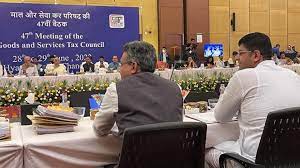01 Jul 2022 47th meeting of the Goods and Services Tax (GST) Council

47th meeting of the Goods and Services Tax (GST) Council – Today Current Affairs
- Recently, in the 47th meeting of the Goods and Services Tax (GST) Council, chaired by the Union Finance Minister, the officials decided to reduce the rates for certain goods and services by largely eliminating the exemption of many consumption items to simplify the rate structure.
Today Current Affairs
GST Council:
- The Goods and Services Tax regime came into force after the Constitutional (122nd Amendment) Bill was passed by both the Houses of Parliament in 2016.
- After this more than 15 Indian states ratified it in their state legislatures, after which the President gave his assent.
- The GST Council is a joint forum of the Center and the States.
- It was established by the President in accordance with Article 279A (1) of the amended Constitution.
Member : The Hindu Analysis
- The members of the Council include Union Finance Minister (Chairman), Union Minister of State (Finance).
- Each State Minister in charge of Finance or Taxation or any other Minister may be nominated as a member.
Work : The Hindu Analysis
- The Council as per Article 279, “to make recommendations to the Center and the States on important issues relating to GST, such as the GST on goods and services subject to or may be exempted from the Model GST laws”.
- It also decides on different rate slabs of GST.
- For example, an interim report of a panel of ministers has suggested a tax of 28% on casinos, online gaming and horse racing.
Recent Events : The Hindu Analysis
- This is the first meeting after the Supreme Court’s decision in May 2022 that the recommendations of the GST Council are not binding.
- The Court observed that Article 246A of the Constitution empowers both Parliament and State Legislatures to “simultaneously” make laws on GST and that the Council’s recommendations are “the result of negotiations involving the Union and the States”.
- This was welcomed by some states like Kerala and Tamil Nadu, who believe that states can be more flexible in accepting recommendations that suit them.
Goods and Services Tax (GST) : The Hindu Analysis
- GST was introduced through the 101st Constitutional Amendment Act, 2016.
- It is one of the biggest indirect tax reforms in the country.
- It was introduced with the slogan ‘One Nation One Tax’.
- Indirect taxes like Excise Duty, Value Added Tax (VAT), Service Tax, Luxury Tax etc. have been subsumed in GST.
- GST reduces the cascading effect of tax or the burden of tax which is passed on to the end consumer.
Tax Structure under GST : The Hindu Analysis
- Central GST to cover excise duty, service tax etc.
- State GST to cover VAT, luxury tax etc.
- Integrated GST (IGST) to cover inter-state trade.
- IGST itself is not a tax but a tax system to coordinate state and union taxes.
- It has a 4-tier tax structure of 5%, 12%, 18% and 28% for all goods and services under the slab.
Reasons for implementing GST : The Hindu Analysis
- To reduce issues like double taxation, cascading effect of taxes, multiplicity of taxes, classification etc. and to create a common national market.
- The GST that a trader pays for the purchase of goods or services (i.e. on inputs) can be set up or set to apply later on the final supply of goods and services.
- Set off tax is called input tax credit.
- Thus GST can reduce the cascading effect of tax as it increases the tax burden on the end consumer.
Importance of GST : The Hindu Analysis
- Creation of a common national market: This will help in creating a unified common national market for India. It will also promote foreign investment and “Make in India” campaign.
- Streamlining taxation: There will be harmonization of laws, procedures and tax rates between the Center and the States and Union Territories. The Hindu Analysis
- Increase in tax compliance: Better compliance environment will be created as all returns will be filed online, input credits will be verified online, paperless transactions will be encouraged at every level of the supply chain.
- Discouraging tax evasion: Uniform SGST and IGST rates will reduce the incentive for evasion by eliminating rate arbitrage between neighboring states and between inter-state sales.
- Bringing certainty: Common procedures for registration of taxpayers, refund of taxes, uniform format of tax returns, common tax base, common system of classification of goods and services will provide more certainty to the taxation system. The Hindu Analysis
- Reduction in Corruption: More use of IT will reduce the human interaction between the taxpayer and the tax administration, which will go a long way in reducing corruption.
- Promotion of secondary sector: It will boost export and manufacturing activity, generate more employment and thus increase GDP with gainful employment leading to real economic growth.
In this article we mention all information about 47th meeting of the Goods and Services Tax (GST) Council Today Current Affairs.


No Comments